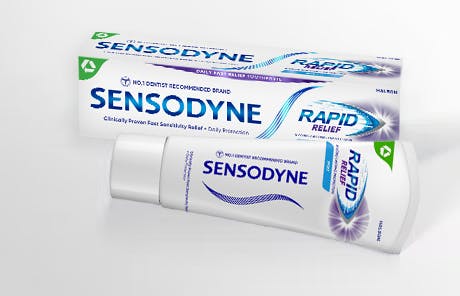- Oral Health Tips
- Recognising Sensitive Teeth
- Managing Sensitive Teeth
- Whitening Sensitive Teeth
- Common Dental Problems
- How to Care for Healthy Teeth and Gums
- Repairing a Chipped or Broken Tooth
- Pain relief for toothache
- That Shock of Pain Could Be Tooth Sensitivity
- A Complete Guide to Temporary Tooth Fillings
- Understanding How Fluoride Works And Helps Prevent Tooth Decay
- What Is the Best Way to Whiten Teeth?
- Tooth Pain | How to Get Relief from Tooth Pain
- Tooth Decay & Tooth Infections Explained
- Abscessed Tooth: Treatment, Causes, Symptoms
- Fluoride In Toothpaste: Uses, Benefits, Side Effects
- All About Dental Caries & Tooth Decay
- How to Ease Pain After Teeth Aligners Treatment
- Home
- Sensitive Teeth Toothbrushes
- Understanding Sensitivity
- About Sensodyne
- Pronamel
- Our Products
- Product Results
- Sensitivity & Gum Toothpaste
- Sensitivity & Gum Whitening Toothpaste
- Rapid Relief
- Rapid Relief Extra Fresh
- Rapid Relief Whitening
- Repair and Protect Whitening
- Repair and Protect Extra Fresh
- Repair and Protect
- Sensodyne Repair Protect toothbrush
- Complete Protection
- Complete Protection Extra Fresh
- Gentle Whitening
- Original Mint
- Extra Fresh
- Deep Clean
- Sensodyne Daily Care toothbrush
- Pronamel Gentle Whitening
- Pronamel Multi-Action
- Pronamel Extra Freshness
- Pronamel Daily Protection
- Pronamel Mouthwash
- Pronamel Intensive Enamel Repair Extra Fresh
- Pronamel Intensive Enamel Repair Whitening
- Cool Mint Mouthwash
- Nourish Healthy White Toothpaste
- Nourish Gently Soothing Toothpaste
- Pronamel Mineral Boost Toothpaste
- Complete Protection Advanced Whitening
- Sensitivity Gum & Enamel Toothpaste
- Sensodyne Clinical White Stain Protector Toothpaste
- Sensodyne Clinical White Enamel Strengthening Toothpaste
- Pronamel Active Enamel Shield Fresh Mint
- Pronamel Active Enamel Shield Whitening
- Pronamel Kids 3-5 Years Strawberry Twist
- Pronamel Junior 6-12 Years Bubble Mint
- Sensodyne Clinical Repair Active White Toothpaste
- Sensodyne Clinical Repair Deep Clean Toothpaste
- Oral Health Tips
- Recognising Sensitive Teeth
- Managing Sensitive Teeth
- Whitening Sensitive Teeth
- Common Dental Problems
- How to Care for Healthy Teeth and Gums
- Repairing a Chipped or Broken Tooth
- Pain relief for toothache
- That Shock of Pain Could Be Tooth Sensitivity
- A Complete Guide to Temporary Tooth Fillings
- Understanding How Fluoride Works And Helps Prevent Tooth Decay
- What Is the Best Way to Whiten Teeth?
- Tooth Pain | How to Get Relief from Tooth Pain
- Tooth Decay & Tooth Infections Explained
- Abscessed Tooth: Treatment, Causes, Symptoms
- Fluoride In Toothpaste: Uses, Benefits, Side Effects
- All About Dental Caries & Tooth Decay
- How to Ease Pain After Teeth Aligners Treatment
- Sustainability
- FAQs
- Contact us
- Where to Buy
- Sensitive Teeth & Gum Toothpaste
- Sensodyne Rapid Relief
- Sensodyne Extra Fresh










